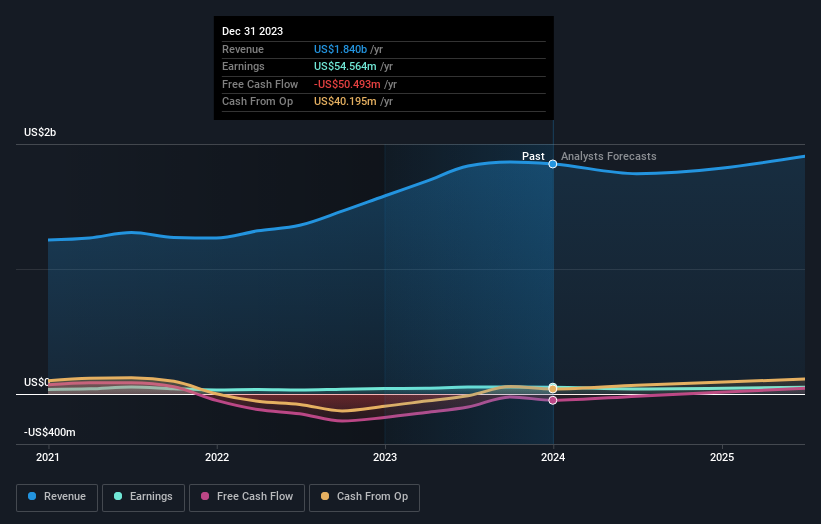Kimball Electronics, Inc. Just Missed Earnings - But Analysts Have Updated Their Models
As you might know, Kimball Electronics, Inc. (NASDAQ:KE) last week released its latest quarterly, and things did not turn out so great for shareholders. Kimball Electronics missed earnings this time around, with US$421m revenue coming in 3.2% below what the analysts had modelled. Statutory earnings per share (EPS) of US$0.33 also fell short of expectations by 18%. Earnings are an important time for investors, as they can track a company's performance, look at what the analysts are forecasting for next year, and see if there's been a change in sentiment towards the company. With this in mind, we've gathered the latest statutory forecasts to see what the analysts are expecting for next year.
Check out our latest analysis for Kimball Electronics
Following the recent earnings report, the consensus from five analysts covering Kimball Electronics is for revenues of US$1.76b in 2024. This implies a discernible 4.2% decline in revenue compared to the last 12 months. Statutory earnings per share are forecast to dive 26% to US$1.62 in the same period. Yet prior to the latest earnings, the analysts had been anticipated revenues of US$1.83b and earnings per share (EPS) of US$1.98 in 2024. The analysts seem less optimistic after the recent results, reducing their revenue forecasts and making a real cut to earnings per share numbers.
It'll come as no surprise then, to learn that the analysts have cut their price target 14% to US$29.40. Fixating on a single price target can be unwise though, since the consensus target is effectively the average of analyst price targets. As a result, some investors like to look at the range of estimates to see if there are any diverging opinions on the company's valuation. Currently, the most bullish analyst values Kimball Electronics at US$34.00 per share, while the most bearish prices it at US$25.00. These price targets show that analysts do have some differing views on the business, but the estimates do not vary enough to suggest to us that some are betting on wild success or utter failure.
Taking a look at the bigger picture now, one of the ways we can understand these forecasts is to see how they compare to both past performance and industry growth estimates. These estimates imply that revenue is expected to slow, with a forecast annualised decline of 8.3% by the end of 2024. This indicates a significant reduction from annual growth of 9.9% over the last five years. By contrast, our data suggests that other companies (with analyst coverage) in the same industry are forecast to see their revenue grow 5.2% annually for the foreseeable future. It's pretty clear that Kimball Electronics' revenues are expected to perform substantially worse than the wider industry.
The Bottom Line
The biggest concern is that the analysts reduced their earnings per share estimates, suggesting business headwinds could lay ahead for Kimball Electronics. Unfortunately, they also downgraded their revenue estimates, and our data indicates underperformance compared to the wider industry. Even so, earnings per share are more important to the intrinsic value of the business. Furthermore, the analysts also cut their price targets, suggesting that the latest news has led to greater pessimism about the intrinsic value of the business.
Keeping that in mind, we still think that the longer term trajectory of the business is much more important for investors to consider. At Simply Wall St, we have a full range of analyst estimates for Kimball Electronics going out to 2025, and you can see them free on our platform here..
It is also worth noting that we have found 1 warning sign for Kimball Electronics that you need to take into consideration.
Have feedback on this article? Concerned about the content? Get in touch with us directly. Alternatively, email editorial-team (at) simplywallst.com.
This article by Simply Wall St is general in nature. We provide commentary based on historical data and analyst forecasts only using an unbiased methodology and our articles are not intended to be financial advice. It does not constitute a recommendation to buy or sell any stock, and does not take account of your objectives, or your financial situation. We aim to bring you long-term focused analysis driven by fundamental data. Note that our analysis may not factor in the latest price-sensitive company announcements or qualitative material. Simply Wall St has no position in any stocks mentioned.

